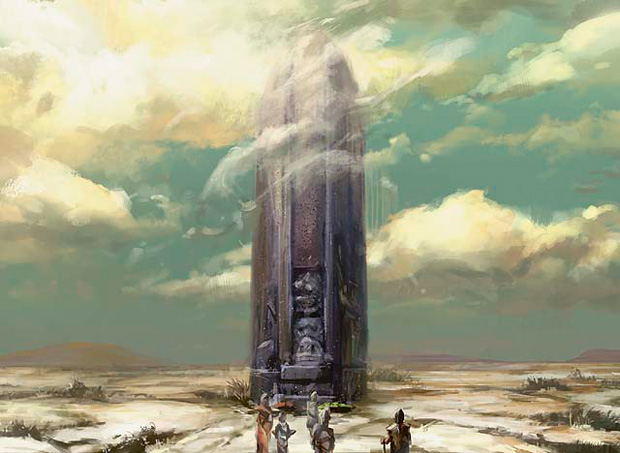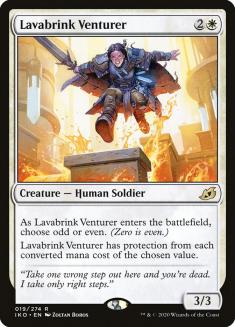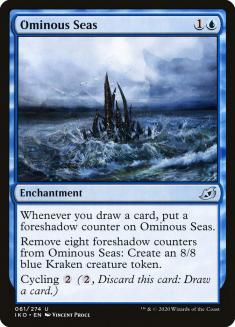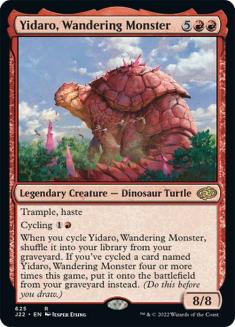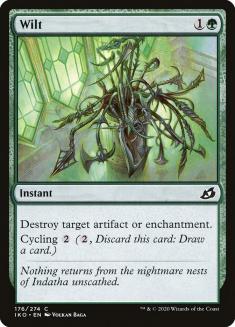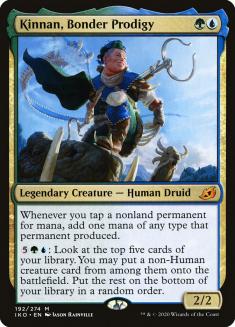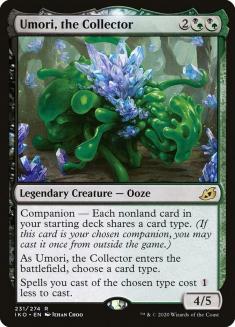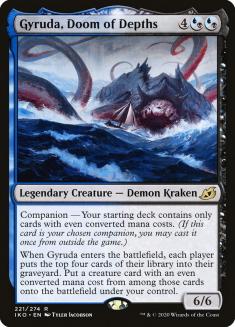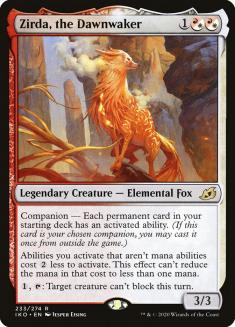There was a time when Legacy players would trawl through every new set, fingers crossed that perhaps they could find a fringe-playable sideboard card for their long-established deck of choice. Once every four or five sets, a truly meaningful print would show up and Legacy would undergo a slow process of change as it contemplated exactly what this new staple meant for every archetype.
Like everything else in the before times, this feels like eons ago. The power level of new Magic cards is at an all-time high, and each set now seems to rebuild Legacy from the ground up. Ikoria: Lair of Behemoths continues this trend, and you can make a case that it is competing with Modern Horizons for the most impactful Legacy set of the modern era. I easily filled the ten slots on this list, and that was after cheating and lumping a group of cards together.
Without further ado, on to our Top 10.
10. Lavabrink Venturer
Creatures (21)
- 3 Aven Mindcensor
- 4 Leonin Arbiter
- 4 Thalia, Guardian of Thraben
- 1 Reality Smasher
- 4 Thought-Knot Seer
- 2 Sanctum Prelate
- 3 Lavabrink Venturer
Lands (19)
Spells (20)

Legacy has always been a format about efficiency. For this reason, Lavabrink Venturer is much closer to True-Name Nemesis than it appears at first glance. Lightning Bolt, Swords to Plowshares, Fatal Push… Lavabrink Venturer laughs them off while safely attacking through many of the most-played creatures in the format. Even when mana-costs do trend higher, cards like Oko, Thief of Crowns; Uro, Titan of Nature’s Wrath; Lurrus of the Dream-Den; Teferi, Time Raveler; and Yorion, Sky Nomad are all incapable of stopping a Lavabrink Venturer set on odd.
Honestly, I could talk myself into being even higher on this card if it were not for its own converted mana cost. As we will discuss at length later in this list, the incentive to keep your permanents’ converted mana costs to two or less is just too great. This is doubly so for decks focused on creatures and attacking. While Mono-White Eldrazi has no capability for complying with that restriction, I would expect most of Legacy’s other creature decks to make the move.
If, for some unpredictable and unforeseen reason, the incentive for an ultra-low curve disappears in a few months, then it’s time to revisit Lavabrink Venturer.
9. Ominous Seas, Shark Typhoon, and Yidaro, Wandering Monster
Creatures (6)
Planeswalkers (4)
Lands (20)
Spells (30)

Creatures (3)
Lands (21)
Spells (37)

Ah, Landstill. As it’s one of the first Legacy archetypes I ever fell in love with, I probably give tools for this deck too much respect because I want it to be good so badly. The reality is that I’m not even sure a two-mana draw-three sorcery would set Legacy ablaze.
Standstill banks upon opponents misplaying to reach its true potential. If you ever find yourself facing a Standstill, remember that you’re almost certainly supposed to break it immediately. This has become even more true with the addition of these three win-conditions.
Ominous Seas actually cranks out 8/8s very quickly in Legacy and seems like the most promising of all these options to me. The fact that it still allows me to play a certain dreamy Cat is no small part of the appeal.
Shark Typhoon requires ample mana, and even decks like Miracles rarely amass the quantity of lands that start to make Shark Typhoon appealing. It’s not clear to me this card is actually better than Decree of Justice, which sees zero play.
When it comes to Yidaro, Wandering Monster, my opinion lies somewhere in the middle (although playing three copies does not make much sense to me). The cheaper cycling cost makes it possible to have this play well in the early stabilizing phase of the game and still get return when it’s actually time to kill your opponent. For now, I’m sticking with Ultimar’s list, but Yidaro is a unique effect and it’s always important to track these for Legacy play.
8. Wilt
Creatures (11)
Planeswalkers (5)
Lands (28)
Spells (36)

Even the most boring of spells is not immune to the absurd power creep of the last two years. Naturalize and Disenchant have long been solid role-players in the format. Wilt is the clearest of upgrades and is still taking full advantage of its two-mana casting cost to dodge Chalice of the Void. Speaking of Chalice of the Void, all the focus on cheap permanents seems like it’s creating a window for these decks to pick up steam again. The Affinity lists that have been circulating lately really seem like the cat’s meow.
Creatures (21)
- 4 Arcbound Ravager
- 4 Steel Overseer
- 4 Phyrexian Revoker
- 1 Hangarback Walker
- 4 Walking Ballista
- 4 Stonecoil Serpent
Lands (21)
Spells (18)

7. Kinnan, Bonder Prodigy
Creatures (5)
Planeswalkers (5)
Lands (20)
Spells (30)

Somehow there are multiple cards in Ikoria that combo with Basalt Monolith to make infinite mana. What a time to be alive! Obviously, one of those cards being a companion does a lot to discredit Kinnan, Bonder Prodigy, but there are some real reasons to consider this card as well.
First, Kinnan combines well with multiple cards that Zirda has no interaction with. Legacy is the format of mana rocks, and Mox Amber, Arcum’s Astrolabe, Mox Diamond, and Lotus Petal are all anxious for a crack at this card. Add in team-up potential with Noble Hierarch and countless other mana creatures and you start to the many branching deck building paths. Whereas Zirda’s interactions are somewhat obvious, Kinnan’s feel like they’re just being unlocked.
Perhaps more important than any of this, Kinnan creates the same combo potential as Zirda but still has a converted mana cost of two or less. Are you starting to see a trend with these breakdowns?
6. Sprite Dragon
Creatures (16)
Lands (16)
Spells (28)
Sideboard

Classic aggressive Delver of Secrets builds will never go out of style, and this is one of the finest we’ve seen in a long time. Sprite Dragon represents a real upgrade to the two-mana creature slot in these decks. It skips the awkward mana and graveyard hate vulnerability that Tarmogoyf usually brings with it.
Short of pure combo, aggressive Delver builds are one of the few reasonable ways to talk yourself into passing on a companion right now. This is a deck that can potentially close doors before a companion has time to create its inevitable swing, while packing just enough disruption to prevent the combo decks from running away with the game.
But what if it fails at this goal, and is forced to play the longer, more intricate games that even more aggressive builds of Delver are occasionally forced into?
Well, it will lose. To Lurrus of the Dream-Den. Like everything else in the format.
5. Umori, the Collector
4. Gyruda, Doom of Depths
Creatures (28)
- 4 Sakashima the Impostor
- 1 Phyrexian Metamorph
- 2 Phantasmal Image
- 4 Evil Twin
- 3 Restoration Angel
- 4 Dack's Duplicate
- 3 Dragonlord Kolaghan
- 4 Spark Double
- 3 Gyruda, Doom of Depths
Lands (16)
Spells (16)

3. Yorion, Sky Nomad
Creatures (12)
Planeswalkers (6)
Lands (27)
Spells (35)

2. Zirda, the Dawnwaker
Creatures (9)
Planeswalkers (6)
Lands (20)
Spells (25)

1. Lurrus of the Dream-Den
Creatures (2)
Lands (20)
Spells (38)

There is no way to address the Top 5 cards on my list without first discussing them as a collective. The companion mechanic is the biggest change in Magic since the nascent days of the game. Sure, things like not playing for ante or the four-card limit mattered more, but practically nobody was playing Magic at that time anyway. Companions are bigger than removing interrupts. Bigger than taking damage off the stack. Bigger than the London or Vancouver mulligans. Yes, even bigger than planeswalkers, at least from a gameplay perspective.
Whether you like or dislike this change, it does you no good to deny it. A recent analysis found that a truly preposterous 68.75% of all decks with a Top 32 finish in recent Legacy premier events contained a companion.
This means that 68.75% of players are starting the game with an extra card in their hand, and the only sacrifice is a deckbuilding restriction of dubious importance. Even if these cards were as innocuous as a Runeclaw Bear, this would be a paradigm-shifting alteration to the way the game is played. But they aren’t Runeclaw Bears. They’re one-card combo engines, and tribal lords, and some of the best value creatures ever printed.
There are very few Legacy decks that can justify excluding a companion at this stage. That means almost every game of Legacy played until either a banning or (sigh) the printing of even more companions has to contemplate a turn where one of these ten specific creatures, all of whom cannot be interacted with while in hand, will eventually attempt to exert its influence. In a format that’s designed to embrace all of Magic history, containing over 19,000 legal cards, almost every game will involve ten… specific… cards. Reading these words back honestly fills me with an existential dread.
I was not afraid of planeswalkers. I applauded removing damage from the stack. I was excited about Modern Horizons and the Commander products being added to Legacy. I even was initially optimistic about the gutting of the Pro Tour and the birth of the MPL.
Companions scare me.
If there is a bright side to all of this, it is that Lurrus is preposterously dominant amongst Legacy decks, making up 47.92% of the aforementioned 68.75% of decks with a companion. Maybe it alone can be banned and things in Legacy can go back to a degree of normalcy. Or maybe if that happens, Zirda and Yorion will rush to pick up the 47% that Lurrus gave back. I honestly have no idea, but I do predict we’ll have the chance to find out.
Let’s talk a bit about the individual cards.
Umori, the Collector’s inclusion on this list is a bit of a lark, and I think either of the “free” companions (Jegantha or Kaheera) could have occupied this spot instead. However, if those cards find success, they do so only off the inherent brokenness of the companion mechanic. Yes, an eighth card in hand, even a vanilla creature, is worth more than a fifteenth sideboard card. No, I don’t think it’s particularly close. If Umori succeeds, though, it will do so because it has brought a new element to an archetype, not solely on the value of its body alone.
Just like in Ikoria Standard, the obvious thing to do is to pair Umori with creatures and I think Boin has done a nice job of that with one of the few archetypes in Legacy that can actually get away with such a configuration — Goblins. However, I think if Umori truly matters in the Legacy format, it will be because of how it is able to combine with either enchantments or artifacts. Presently, decks like Affinity are incredibly incentivized to build around Lurrus. Were they to lose that option, I don’t hate Umori as a curve-topper.
Meanwhile, Enchantress decks haven’t actually needed to play Argothian Enchantress for a long time. Is it possible there’s a rebuild available focused on Umori? This question hasn’t been answered yet, but Umori is a companion with an actual restriction. I expect it will be slower on the uptake than its unburdened brethren.
When Underworld Breach was previewed, I was initially unimpressed by people illustrating how simple it was to kill an opponent on Turn 1. Killing an opponent on Turn 1 is easy in Legacy, assuming they do not interact with you (Goblin Charbelcher has been around forever). What ultimately pushed Underworld Breach to a banning was its hybridization with other strategies such as Delver and its inclusion of its own disruptive elements like Force of Will.
Gyruda decks are in the Turn 1 kill stage presently. They do this trick slightly better than Charbelcher decks by virtue of always having their combo piece available. This is an upgrade, but not enough to make the deck Tier 1. If Gyruda finds a secondary plan (a combination with traditional Reanimator strategies perhaps?) or a reasonable disruption suite (Daze and Pact of Negation are still on the table) then maybe this deck becomes the next big combo deck to fear. The potential is there.
Recognize that companions are broken but none of them fit with your deck’s theme? Time to pick out twenty more cards and grab Yorion, Sky Nomad!
Okay, so the calculus is a bit more complicated than that, and Yorion obviously benefits from the fact that most of the fair decks in the format were already playing Arcum’s Astrolabe anyway. But there’s no question that a free 4/5 flyer benefits fair blue decks far more than the 80-card restriction hampers them. In most cases, the addition of some extra Preordains or Accumulated Knowledges and a couple of copies of Abundant Growth wil keep the ratio of filtering to payoffs close to 60-card levels. It’s not even like these decks have to dramatically decrease Turn 0 interaction since no deck was maxing out on Force of Negation anyway. Baleful Strix, Icefang Coatl, Snapcaster Mage… these aren’t concessions to Yorion. These are some of the best creatures in Legacy.
Here’s a card that is claiming an incredibly high ranking based on a lot of latent potential. Unlike in the case of Gyruda, Zirda isn’t trying to create a combo from the ground up. Instead, it is installing an additional win condition in already promising combo decks. Bomberman has been on the cusp of greatness since the printing of Mystic Forge. With the addition of Zirda, it’s been thrown back to the drawing board once more and while it hasn’t claimed any top tier successes yet, you just feel them coming.
Right now, the deck is sorting out its technology. Blue-based Prophet of Distortion builds; Emry, Lurker of the Loch / Urza, Lord High Artificer combinations; Kinnan team-ups… all have seen some success thus far. However, consensus on the best build has not been reached. Once that happens, I believe Zirda decks can claim Tier 1 status, elevating Basalt Monolith to heights it has not seen in ages.
What can I really say about Lurrus? Here is a list of archetypes I’ve seen it appear in during the past week:
- Sultai Delver
- Grixis Delver
- Jeskai Delver
- Bant Delver
- Death and Taxes
- Storm
- Affinity
- Jeskai Miracles
- Painter
- Golgari Depths
- Golgari Midrange
- Doomsday
- Cephalid Breakfast
- Yorion Bant Midrange (maindeck)
- Elves
I know I’m missing many more. The proliferation of this card has been so dramatic because the deckbuilding restriction around Lurrus is near inconsequential for much of Legacy. I want to be very clear about this. Lurrus is the most impactful Legacy printing since Force of Will. All the games of Legacy you’ve played that were about gaining and maintaining a small resource edge? Those games are now about resolving a Lurrus. The games as combo where your hand is picked apart and you have to sweat the top of your deck hoping to rebuild? Just resolve a Lurrus. Need a B-plan when everything has fallen apart? Beatdown with Lurrus.
Wizards of the Coast (WotC) is designing cards without regard for their impact on eternal formats. Honestly, I would be completely okay with this if it were just quirky card interactions taking over the format. You just can’t account for every interaction in a pool of 19,000+ cards and attempting to do so would only stifle creativity. My true concern is that cards are being printed at a power level that invalidates everything that came before them. Did Lurrus need to be a 3/2? With lifelink? Can there at least be some part of the card that isn’t mindbogglingly good if it’s going to be a free eighth card in hand?
Lurrus is just the latest example of a trend, and it seems like it won’t be the last. Play this card until it is taken away from you. And get ready to do this again next set.

